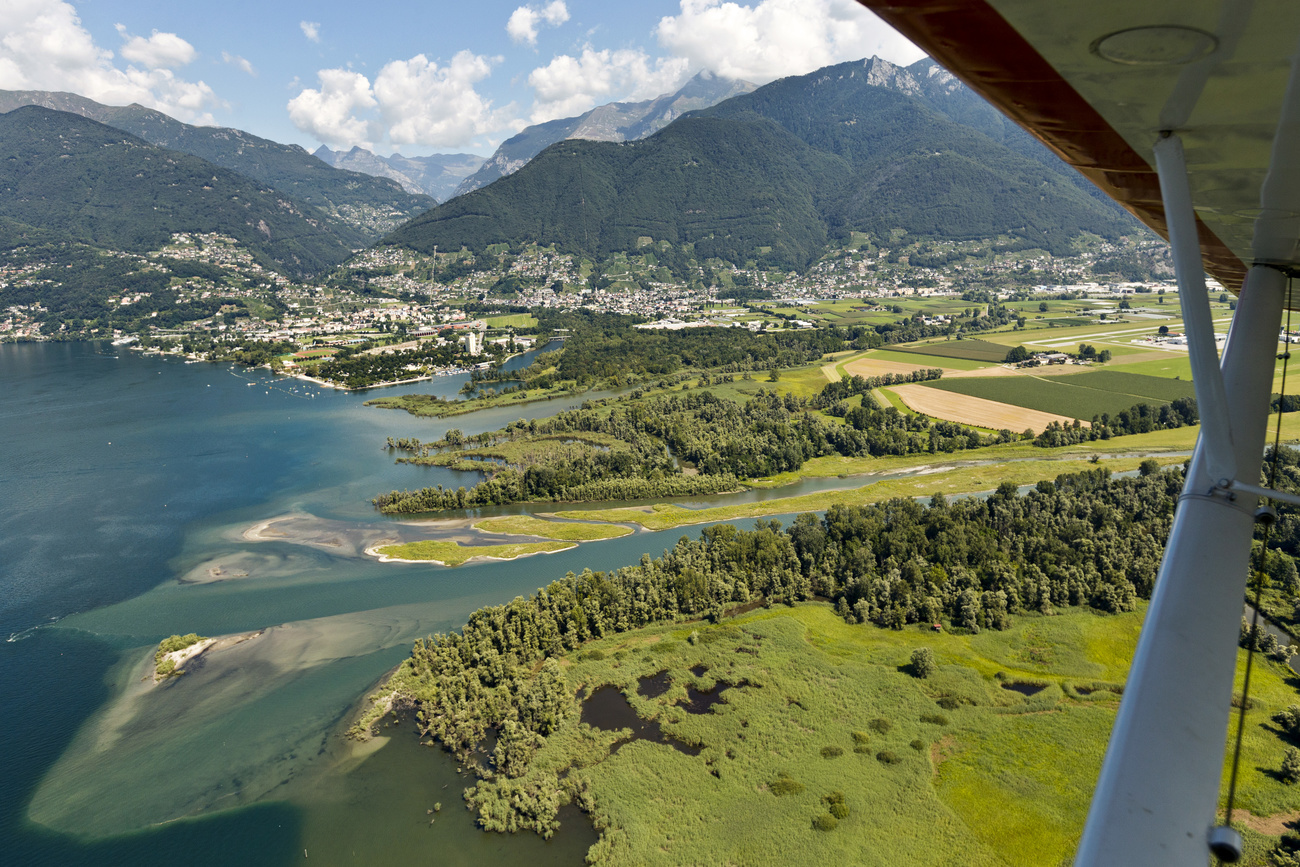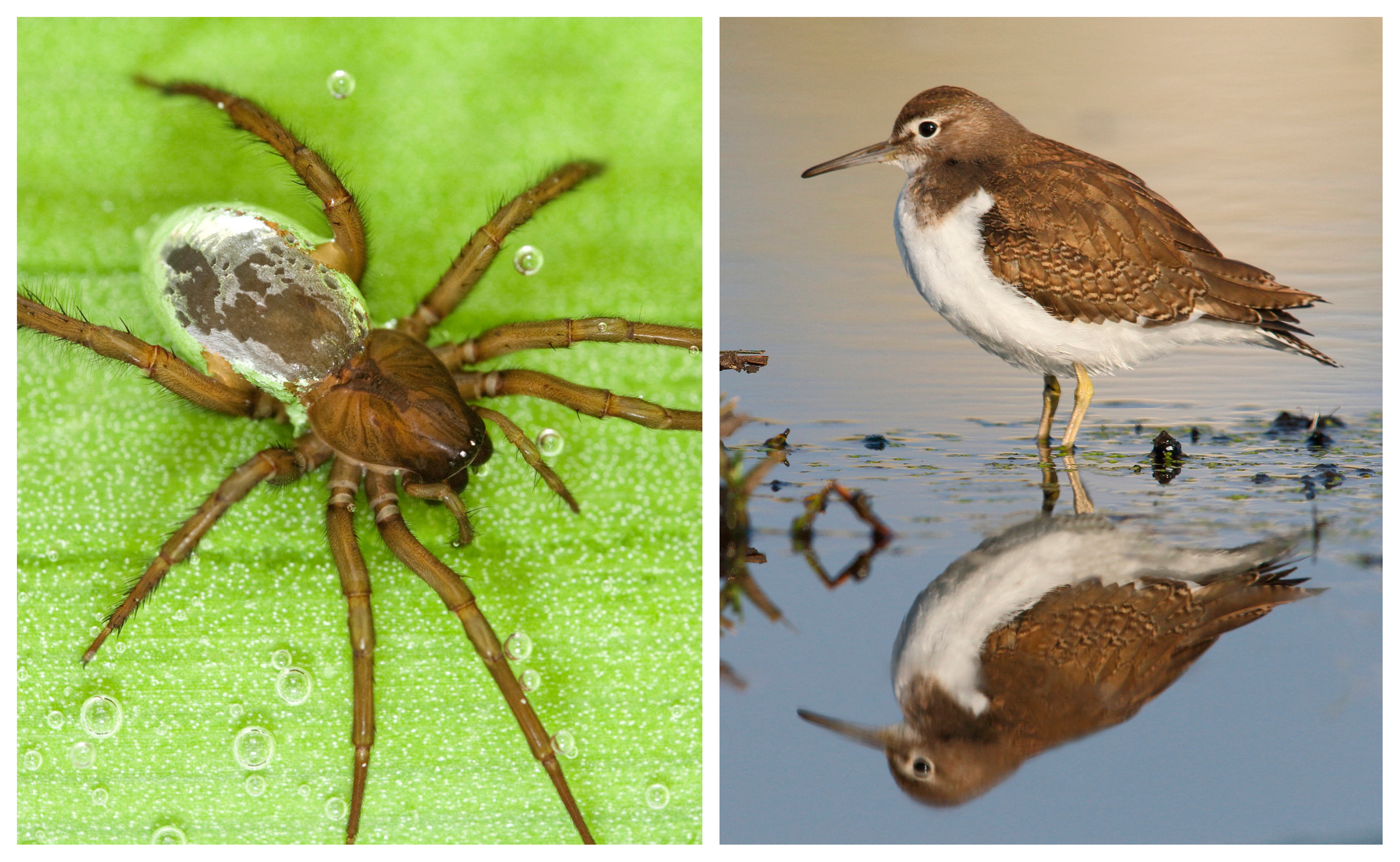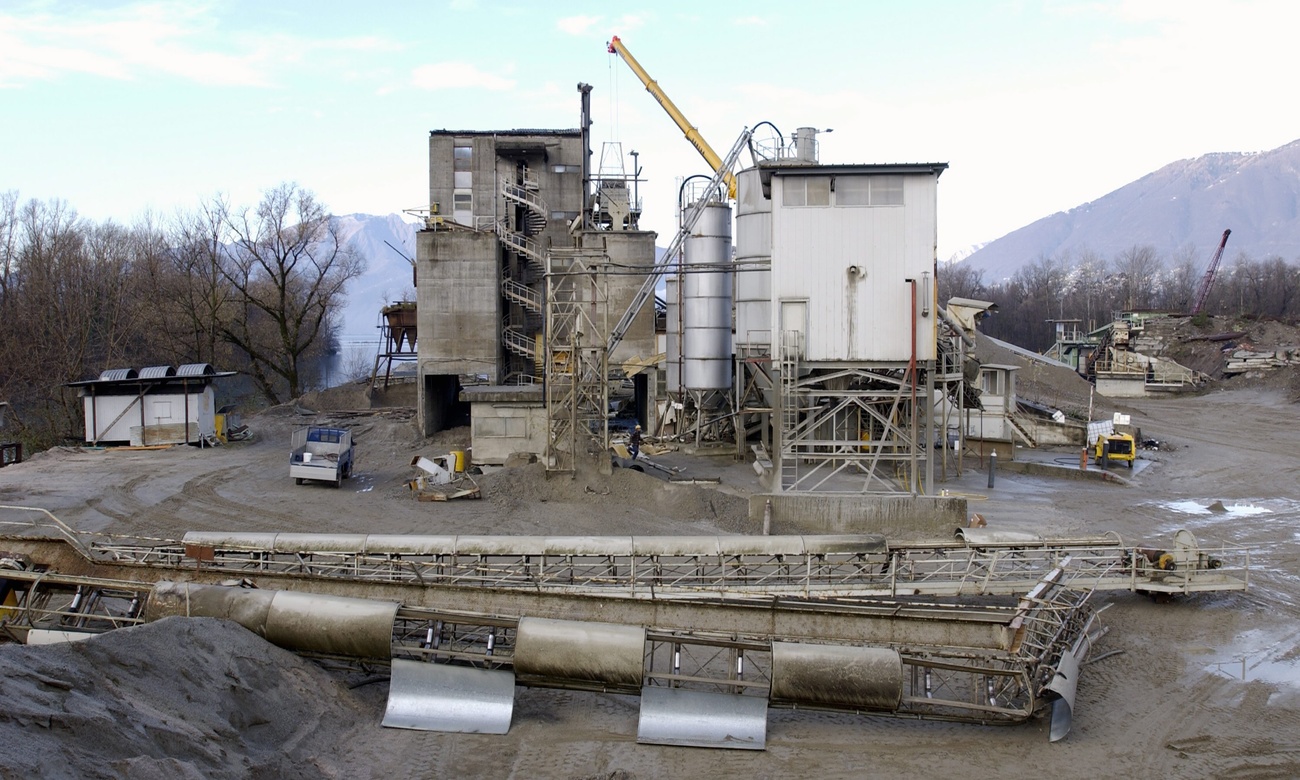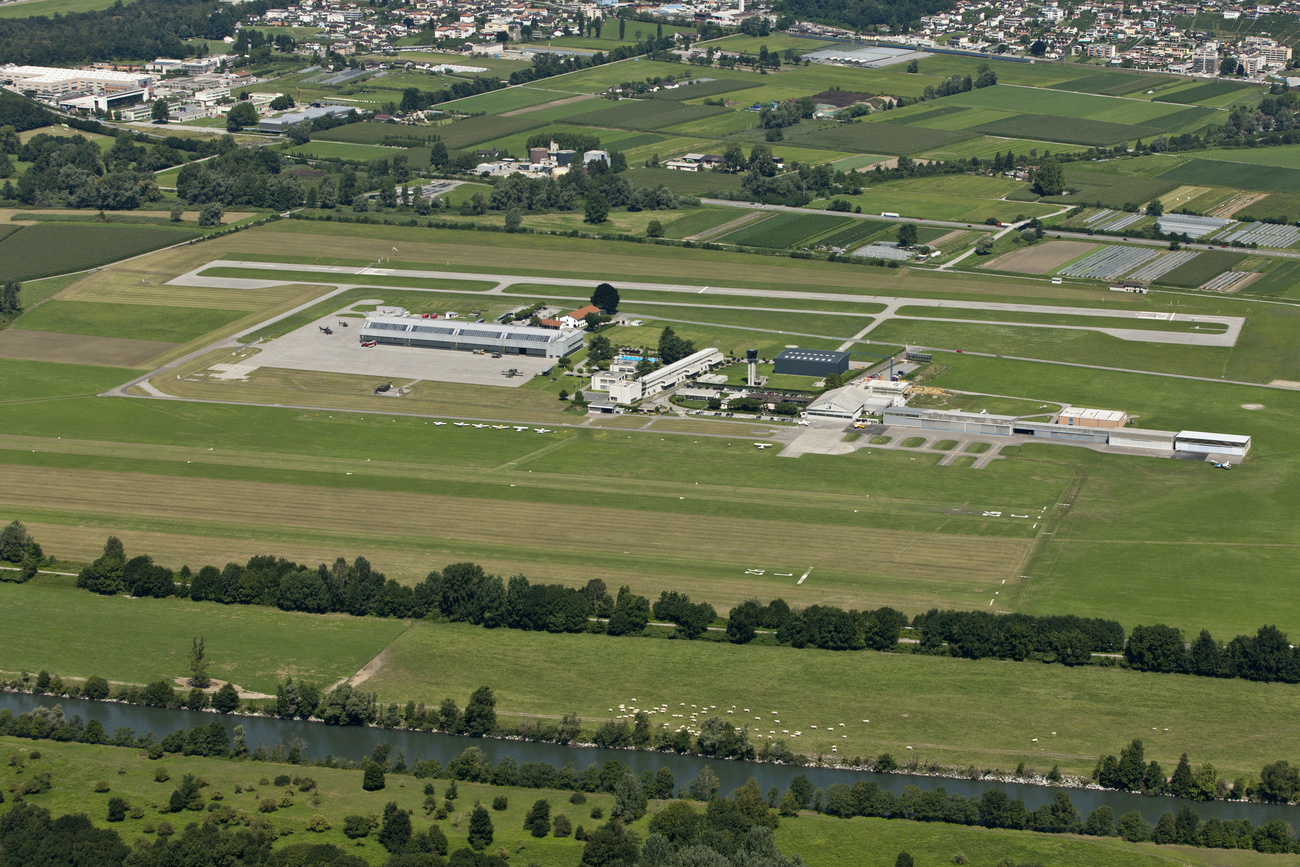
Key Swiss sanctuary reveals challenges, opportunities in biodiversity protection

A global treaty currently on the table seeks to protect 30% of the world’s land and oceans. Switzerland itself is far from this goal, but a unique nature preserve in the country’s Italian-speaking region shows how it can be done.
“In the long run, if nature loses, we all lose!” says Nicola Patocchi of the successes and defeats in his 25-year career as scientific director of the Bolle di Magadino Foundation.
We are on a terrace from which you can enjoy a magnificent view of the northern part of Lake Maggiore, one of the long lakes along the Swiss-Italian border. Patocchi points out a group of deer crossing the shallow waters. They disappear into the reeds, which are one of the main features of this marshy area known as the Bolle di Magadino.
But this area is more than a swamp – it’s a “wetland of international importance” recognised by the Ramsar Convention, the first intergovernmental treaty on the conservation and management of natural ecosystems, signed in Ramsar, Iran, in 1971.
It is also one of few protected biodiverse areas in Switzerland; with around 12% of its territory marked as nature preserves, the Alpine country comes nearly last in Europe for land protection (see box).
The United Nations Conference on Biodiversity (COP15), originally scheduled for this year in Kunming, China, will discuss a deal to protect 30% of the world’s land and oceans. The conference will now take place in December in Canada.
Referred to as “30×30”, this clause is a cornerstone of the Global Framework Agreement for Action designed to address global biodiversity loss. A 2019 UN report predicted that about one million species worldwide are at risk of extinction and many could disappear within a few years unless something is done.
The ambitious goal of COP15 is to halt the decline in biodiversity by 2030 and to begin restoring it by 2050.
“With the loss of species, which are all interconnected, the functions of nature that form the fabric of life vanish,” says Cornelia Krug. She is a senior scientist at the University of Zurich who co-authored the studyExternal link providing the scientific basis for the Framework Agreement to be discussed at COP15.
“Also at risk is our identity, our sense of belonging, our ‘home’, which is formed by nature and biodiversity,” Krug says. “If you grew up in a certain area, you will remember the particular smell of a forest or birdsong. All this will disappear if biodiversity is not protected”.
The Federal Office for the Environment says that 13.4% of Switzerland’s territory is designated for the protection of biodiversity. The international database protectedplanet.net estimates Switzerland’s protected area at about 12%. By comparison, Italy has protected 21% of its land, France 28%, Austria 29%, Germany 37% and Luxembourg some 51%.
This map comparing a topographic map from 1862 with current aerial images shows how the Ticino riverbed changed as a result of reclamation works, helping to form the Bolle di Magadino.
Exemplary ecosystem
But researchers say that simply labelling large areas of land as protected is not enough to combat biodiversity loss. It is important to have a wide range of different ecosystems, each of which attracts and sustains certain species.
The Bolle di Magadino is a prime example. Nearby Lake Maggiore has a large catchment area as well as a small and narrow exit from which the water flows slowly. The monsoon-like rains that fall in the region can cause a very rapid rise in the level of the lake, which regularly floods the nature reserve.
“The animals and plants we find here have specific characteristics that allow them to survive in a selective environment,” says Patocchi of the Bolle di Magadino foundation.
An example is the water spider (Argyroneta acquatica) which takes refuge underwater to escape predators, where it can breathe thanks to an air pocket that it builds with its web.
Another is the small pyro (Actitis hypoleucos), a wading bird that nests on the ground and hides among young plants that grow in environments previously destroyed by the floods.

A ‘petrol station’ for migrating birds
The Bolle di Magadino is internationally significant because it is an important stop on the migration route for many birds heading north from Africa in the spring.
The low-altitude marsh (about 200 metres above sea level) is rich in insects. Migrating birds can arrive easily and fuel up for one of the most demanding stages of their journey: crossing the Alps.
Feeding migrating birds “is the most important function of [such] sites from a global point of view,” explains Krug.
Mimicking nature
This system doesn’t operate on its own, however. The management of the Bolle di Magadino requires continuous human intervention to ensure that such ecological processes continue. For example, says Patocchi, the nearby river used to create ten natural “ponds” when it flooded. This is no longer the case because of past land reclamation work, but it’s possible to create one such pond and resulting biotope with a digger.
Work is currently underway to restore the reed bed in the areas of the Bolle di Magadino where the ashy willow tree now thrives. Both reeds and the willows are typical of the reserve, but scientists have found that the reeds make a better host for key species in Switzerland.

Planes and birds
Patocchi is also engaged in a unique form of diplomacy. Switzerland is densely populated, so the interests of the protected area, its fauna and flora must be constantly weighed and defended against the interests of the human population.
Locally, one of the biologist’s biggest concerns is the nearby airfield. A study carried out by the Bolle di Magadino Foundation has shown that there is a direct correlation between the frequency of flights and the number of migratory birds that will land in the protected area.
The speed and silhouettes of the aircraft are reminiscent of those of predators, and the birds hide from them instead of feeding and recharging their batteries before their Alpine flight. As a result, says Patocchi, “they start again with a half-empty tank and this greatly increases their likelihood of mortality along the way to breeding territories”.
For two migratory species of reference, the disturbance caused by planes resulted in birds putting on 15% to 25% less weight before their onward journey.
And airport security directives require that the riskiest birds be removed from planes’ take-off and landing trajectories to prevent “bird strike” accidents. Patocchi fears that in case of a lethal bird strike accident, the authorities would have no choice but to either close the airport or destroy the reserve.
“Fortunately, there have never been any serious accidents, but if there were, in all likelihood we would be faced with a decision about which survives,” he says.
A new operating regulation for the airfield that accounts for coexistence with the nature reserve is being examined by the federal authorities, alongside an infrastructure project that provides for an extension of the airport. A compromise has not yet been found.

Water level wars
The Bolle di Magadino reserve must also contend with a conflict in neighbouring Italy, in whose territory about 80% of Lake Maggiore is located. A long-standing conflict pits agricultural producers in the nearby Po Valley against municipalities on the banks of the lake.
The municipalities hope that the average lake level will be kept lower to limit the risk of flooding in the event of heavy and sudden rains. Farmers, on the other hand, would like a high lake level during the winter months to ensure water supply for their crops and animals during periods of drought.
“In 2021 […], the harvest was only saved thanks to an unexpected summer storm,” a farmer recently told tvsvizzera.it.
A higher average water level would also affect the Bolle di Magadino. Half a metre more water in spring would “suffocate” about 60 hectares of swamp, explains Patocchi.
To bring the interest of the protected area to the negotiating table, Patocchi’s foundation is currently participating in an interregional study using radar, positioned a few kilometres away, to monitor the passage of birds in the skies above. The aim is to understand what influence the water level has on the decision of migratory birds to stop for food in the area.
A guarantee against climate change
Getting biodiversity to develop in the Bolle di Magadino and other areas located between Switzerland and Italy is not only in the interest of ornithologists. The few remaining places where great biodiversity can be observed are threatened by human activity and climate change.
“With rising temperatures, there is a risk of mismatches, for example, between when birds decide to move and when insects and food abound,” says Krug. Plants and animals may also struggle to withstand the extreme events that climate change will cause with increasing frequency, such as storms, landslides, fires and long periods of drought.
If maintained, biodiverse wetlands can also offer a guarantee against climate disruption. For example, says Krug, “wetlands can collect excess water and protect surrounding areas from flooding, and they can also absorb excess carbon dioxide in the atmosphere and store it in vegetation and soil”.
“The more biodiversity there is, the more a system has the concrete capacity to adapt,” adds Patocchi. “If biodiversity is lost, the system becomes rigid and breaks down.”
Edited by Veronica De Vore and Sabrina Weiss
More

In compliance with the JTI standards
More: SWI swissinfo.ch certified by the Journalism Trust Initiative






























You can find an overview of ongoing debates with our journalists here . Please join us!
If you want to start a conversation about a topic raised in this article or want to report factual errors, email us at english@swissinfo.ch.